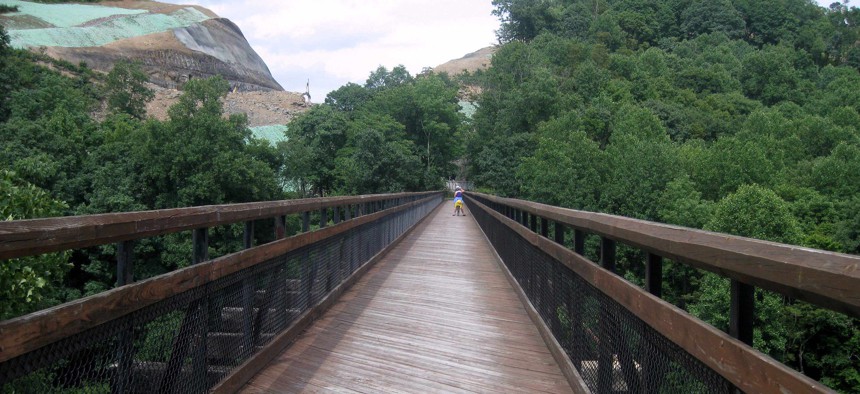The Push to Build a Coast-to-Coast Trail for Cyclists and Pedestrians

In this July 13, 2012, file photo, a bicyclist participating in a three-day ride of the Great Allegheny Passage between Pittsburgh and Cumberland, Md., crosses a bridge near Confluence, Pa. AP Photo/Cal Woodward, File

Connecting state and local government leaders
“We’re confident that this is something we can do,” says a policy adviser with the advocacy group backing the idea.
Connecting the nation’s east and west coasts with a nearly 4,000 mile trail that could accommodate bicyclists or people traveling by foot may sound to some like an audacious plan.
Kevin Mills, senior vice president of policy for the Rails-to-Trails Conservancy, concedes as much.
But, after more than 18 months of analysis and discussions, his organization believes it’s a feasible idea. “We’re confident that this is something we can do,” Mills said during a phone interview last week.
“It will take some effort over a period of years to bring it together of course,” he added.
The Rails-to-Trails Conservancy was founded in the 1980s. Its mission is reflected in its name: it works to convert unused railroad corridors, and other spaces, into public trails. The idea of a transcontinental path has been alive within the organization since its early days, Mills said.
It wasn’t until the past couple of years, though, that the conservancy began to look more closely at the idea. Mills explains that part of what it was waiting for was enough segments of trail to be completed around the U.S. to potentially make up about half of the route, a threshold the group says has now been reached.
Examples of these existing segments include the Chesapeake & Ohio Canal National Historical Park trail, which runs about 185 miles between Washington, D.C., and Cumberland, Maryland.
To the west, there is also the Ohio to Erie Trail, which spans about 270 miles between Cincinnati and Cleveland. Shorter offerings were built too, like the Casper Rail Trail in Wyoming, a six-mile connector in one of the Cowboy State’s largest cities.
There are nine other trails of varying lengths the conservancy has identified as options for incorporating into the nationwide route, including the 212-mile Palouse to Cascades State Park Trail, in Washington state—envisioned as the national trail’s western terminus.
Come May, the group intends to release more details about its plans, including a finished “needs assessment” and a map with specific route options. After that, the conservancy will likely turn its attention to “catalytic projects” that could help fill in gaps between existing trails.
So far the conservancy doesn’t have concrete cost estimates or timeline goals it’s willing to share publicly. Mills described state and federal dollars are the most obvious funding sources for completing the trail, but noted that private money could also flow toward some segments.
Part of the group’s work involves communicating with state officials, often transportation and parks department heads, about the prospect of the trail, to gauge and build political will.
“Typically people are impressed with the vision and they want to be part of it,” Mills said.
“We have observed over the years that highly successful statewide trails are typically championed by their states,” he added.
The conservancy is trying to plan the route so it maximizes the amount of trail built upon old railroad rights of way, which tend to have gentle grades, rather than steep hills. But it could traverse other types of land. Surfaces would likely be pavement, crushed limestone, or gravel.
If the project comes together as it’s tentatively imagined a person on a mountain bike, or road bike with wider tires, would be able to ride from the D.C. metro area, to Washington state, while avoiding the stress and risks of busy roads. Mills acknowledges that if the project moves ahead, there could be phases where it incorporates some road travel, before the entire trail is complete.
But why do it? Are that many people really clamoring to cycle from one coast to the other on a trail? Mills makes a few points here, some of which have to do with the different types of users.
Adventure tourism companies and others, he says, anticipate that there will likely be demand from riders interested in completing coast-to-coast rides, which raises the possibility of “eco-tourism,” and the boost it could provide to rural communities along the route.
And while some people might travel the route in one shot, others might do it in pieces, over several years, Mills added. This is similar to the way some hikers travel the Appalachian Trail.
But there’s also an expectation that the nationwide bike and pedestrian thoroughfare, if it does come to fruition, would be an asset for local users as well, who might choose to use it on the weekend or for a daily bicycle commute, with local trails serving as branch routes.
Mills likens it to the interstate highway system, which is used for both long and short-distance travel.
“Part of the reason why it’s going to work is because we’re getting richer and richer regional trail networks in all the towns along the route,” he said. “So what we see is this is kind of the spine.”
“If you think about it that way, where it’s part of a nationwide network that’s bringing greater connectedness and vitality to all of the regional networks along the way and that you’ll have users of all those sorts,” he added, “you start to get the feel for the why.”
Bill Lucia is a Senior Reporter for Route Fifty and is based in Washington, D.C.

NEXT STORY: Cities Aren’t Built for Parents





